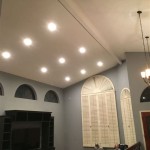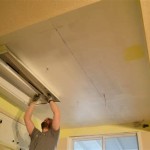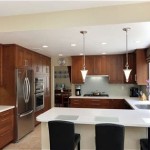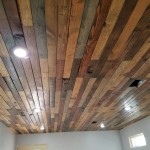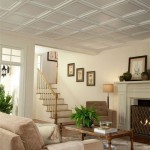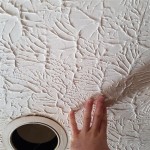Simple Ceiling Design for Living Room: A Comprehensive Guide
The living room, often the central hub of a home, warrants careful consideration when it comes to design elements. The ceiling, frequently overlooked, plays a significant role in the overall aesthetic and ambiance of the space. Simple ceiling designs can effectively enhance the living room's appeal without overwhelming the existing decor. This article explores various simple ceiling design options suitable for living rooms, focusing on materials, styles, and practical considerations.
Understanding the Role of Ceiling Design
Ceiling design extends beyond mere covering. It impacts lighting, acoustics, and the perceived size of the room. A well-designed ceiling can make a small living room feel more spacious, while a poorly designed one can make a large room feel cavernous. Simple designs often prioritize functionality and ease of maintenance, making them ideal for modern living spaces where clean lines and minimalist aesthetics are prevalent.
The primary functions of a ceiling include:
- Providing a finished surface to conceal structural elements.
- Improving insulation for temperature control.
- Reducing noise transmission between floors.
- Housing lighting fixtures and other utilities.
- Contributing to the overall aesthetic appeal of the room.
By carefully considering these functions, one can select a simple ceiling design that effectively addresses practical needs while enhancing the living room's visual appeal.
Popular Simple Ceiling Design Options
Several simple ceiling design options cater to a wide range of aesthetic preferences and functional requirements. These include:
1. Flat Ceiling:
The flat ceiling, also known as a conventional ceiling, is the most common and simplest option. It involves a smooth, uniform surface that is typically painted. Flat ceilings are easy to install and maintain, making them a cost-effective choice. They provide a neutral backdrop that allows other design elements in the room to take center stage.
Materials commonly used for flat ceilings include:
- Drywall (Gypsum Board): This is the most popular choice due to its affordability, ease of installation, and ability to create a smooth, seamless surface. Drywall can be painted, textured, or wallpapered.
- Plaster: Plaster offers a durable and aesthetically pleasing finish. It is more labor-intensive to install than drywall but provides a higher-quality look and feel.
- Wood Planks (Shiplap): While not technically a flat surface due to the slight grooves, shiplap can create a simple and visually appealing ceiling. It adds a touch of rustic charm and can be painted or stained.
2. Tray Ceiling:
A tray ceiling features a recessed central area, creating the illusion of height. This design element adds dimension and visual interest to the living room without being overly complex. The recessed area is typically painted a lighter color than the surrounding ceiling to enhance the sense of spaciousness.
Tray ceilings can be adapted to various architectural styles. For a modern look, clean lines and minimalist detailing are preferred. For a more traditional aesthetic, decorative moldings and trim can be added to the edges of the tray.
3. Coffered Ceiling:
A coffered ceiling is characterized by a series of recessed panels, or coffers, creating a grid-like pattern. This design adds a sense of depth and architectural interest to the living room. While coffered ceilings can be elaborate, simple versions featuring clean, geometric shapes offer a sophisticated and understated look.
Coffered ceilings are typically constructed using:
- Wood: Wood offers a warm and inviting aesthetic. It can be stained or painted to match the room's decor.
- Drywall: Drywall is a more affordable option that can be used to create simple coffered designs. It is typically painted white or a light color to maximize the sense of openness.
4. Exposed Beam Ceiling:
Exposed beam ceilings showcase the structural beams of the roof or floor above. This design element adds a rustic and industrial touch to the living room. While traditionally associated with older homes, exposed beam ceilings can also be incorporated into modern designs.
The beams can be:
- Original Structural Beams: These beams are often made of wood and may have a weathered appearance.
- Decorative Beams: These beams are typically made of wood or composite materials and are added for aesthetic purposes. They can be stained or painted to complement the room's decor.
5. Suspended Ceiling (Drop Ceiling):
A suspended ceiling, also known as a drop ceiling, is a secondary ceiling that is hung below the main structural ceiling. This type of ceiling is often used in commercial spaces but can also be adapted for residential use. Suspended ceilings are typically made of lightweight tiles or panels that are suspended from a metal grid.
Suspended ceilings offer several advantages:
- Concealing Utilities: They can effectively conceal wiring, ductwork, and plumbing.
- Improving Acoustics: They can improve the room's acoustic properties by absorbing sound.
- Easy Access: The tiles or panels can be easily removed for maintenance or repairs.
While suspended ceilings are often associated with a more utilitarian aesthetic, modern designs featuring sleek tiles and minimalist grids can be quite stylish.
Material Considerations for Ceiling Design
The choice of materials plays a crucial role in determining the aesthetic and functional properties of the ceiling. Consider the following materials when selecting a ceiling design:
1. Drywall (Gypsum Board):
Drywall is the most widely used material for ceilings due to its affordability, ease of installation, and versatility. It can be painted, textured, or wallpapered to achieve a wide range of looks. Drywall is also fire-resistant and provides good sound insulation.
2. Wood:
Wood adds warmth and natural beauty to a living room. It can be used for exposed beams, coffered ceilings, or plank ceilings. Different types of wood, such as pine, oak, and cedar, offer varying textures and tones.
3. Metal:
Metal ceilings offer a sleek and modern aesthetic. They are durable, fire-resistant, and easy to clean. Metal ceilings are available in a variety of finishes, including brushed nickel, copper, and stainless steel.
4. Plaster:
Plaster is a durable and aesthetically pleasing material that has been used for ceilings for centuries. It provides a smooth, seamless finish and can be molded to create decorative details. Plaster is more expensive and labor-intensive to install than drywall but offers a higher-quality look and feel.
5. Acoustic Tiles:
Acoustic tiles are designed to absorb sound and reduce noise levels. They are often used in home theaters, music rooms, and other spaces where sound control is important. Acoustic tiles are available in a variety of materials, including mineral fiber, fiberglass, and fabric-wrapped panels.
Lighting Integration in Simple Ceiling Design
Lighting is an integral part of ceiling design. The type and placement of lighting fixtures can significantly impact the ambiance and functionality of the living room.
Consider the following lighting options when designing a simple ceiling:
1. Recessed Lighting (Pot Lights):
Recessed lighting provides a clean and minimalist look. The fixtures are installed flush with the ceiling, creating a seamless appearance. Recessed lighting is ideal for general illumination and can be used to highlight specific areas of the room.
2. Chandeliers:
Chandeliers add a touch of elegance and sophistication to the living room. They are typically suspended from the center of the ceiling and provide ambient lighting. When selecting a chandelier, consider the size and style of the room.
3. Pendant Lights:
Pendant lights are similar to chandeliers but are typically smaller and more versatile. They can be used individually or in groups to provide task lighting or accent lighting. Pendant lights are available in a wide range of styles and materials.
4. Track Lighting:
Track lighting consists of a series of light fixtures that are mounted on a track. The track can be installed on the ceiling or walls, providing flexible lighting options. Track lighting is ideal for highlighting artwork or architectural features.
5. Cove Lighting:
Cove lighting involves installing light fixtures behind a molding or ledge, creating a soft and diffused glow. This type of lighting adds a sense of warmth and ambiance to the living room. Cove lighting is often used in tray ceilings and coffered ceilings.
By carefully considering the lighting options and integrating them seamlessly into the ceiling design, one can create a living room that is both functional and aesthetically pleasing.
Practical Considerations for Simple Ceiling Design
Beyond aesthetics, several practical considerations should be taken into account when selecting a simple ceiling design:
1. Budget:
Ceiling design costs can vary significantly depending on the materials, complexity of the design, and labor involved. Establish a budget before starting the project and choose a design that fits within the allocated funds.
2. Room Size and Height:
The size and height of the living room will influence the choice of ceiling design. In small rooms, avoid overly complex designs that can make the space feel cramped. In rooms with low ceilings, opt for designs that create the illusion of height, such as tray ceilings or light-colored surfaces.
3. Architectural Style:
The ceiling design should complement the overall architectural style of the home. A modern living room might benefit from a sleek, minimalist ceiling, while a traditional living room might be better suited to a coffered ceiling or exposed beam ceiling.
4. Maintenance:
Consider the ease of maintenance when selecting a ceiling design. Flat ceilings are the easiest to clean and maintain, while more complex designs may require more frequent attention. Choose materials that are durable and easy to wipe down.
5. Building Codes and Regulations:
Ensure that the ceiling design complies with all relevant building codes and regulations. This is particularly important when making structural changes or installing new electrical wiring. Consult with a qualified contractor or architect to ensure compliance.
By addressing these practical considerations, one can select a simple ceiling design that is not only aesthetically pleasing but also functional, durable, and compliant with all relevant regulations.

15 Creative Living Room Ceiling Ideas In 2024

Simple Ceiling Designs For Living Room Design False

33 Stunning Ceiling Design Ideas To Spice Up Your Home Simple Modern Living Room

7 Simple False Ceiling Design Ideas For Your Hall Designcafe

Best False Ceiling Designs For Living Room Designcafe

Latest False Ceiling Designs For Drawing Room Beautiful Homes

Simple False Ceiling Design Colorwale

Living Room Ceiling Design At Rs 350 Square Feet In Faridabad

Cost Of False Ceiling Design For Living Room Decorpot Home Interiors

Simple Ceiling Designs To Beautify Your Home
Related Posts

